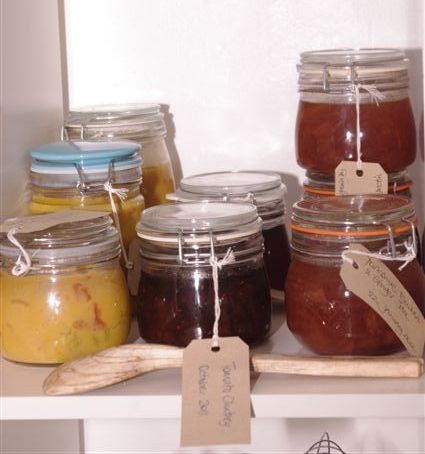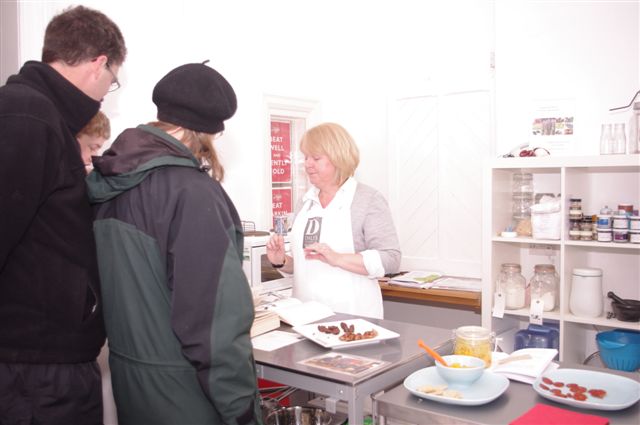A Feast of Yorkshire Dales Food
I travelled to the Dales Countryside Museum at Hawes to meet Jane Sammells, who was working on a project on Yorkshire Dales food. When she mentioned that it was a subject ‘close to her heart’, I shared her sentiment.
What could be more delicious that succulent Yorkshire bacon, fresh Dales cheeses, a good chunk of beef – and all that Dales baking!
I still recall James Herriott’s description of the baking laid on by his future wife on his first visit to her home: pies, cakes, scones. A complete feast, but a feast laid on for so many visitors to Yorkshire homes.
But how far back does it all go, in terms of tradition?
As well as working at the Dales Countryside Museum, Jane also visits schools to lead historic cookery workshops. She’s covered many periods, and has seen how food fashions have changed over the centuries.
Roman food, she comments, ‘tastes weird to us’. It’s possibly a bit like Thai food, as the Romans favoured a fermented fish sauce.
Vikings in the Dales probably ate mainly what they could produce locally, and Jane thinks the sheep was the mainstay of their lives. “You could get more yield from sheep on a given piece of land than cows. And the sheep produced wool as well as milk, meat and leather,” she comments.
“I think the Vikings ate a lot of black-pudding-ey, haggis-ey type things. They ate Spelt bread – an ancient variety of wheat – and lots of oats. They made a sort of porridge that they left to dry by the fire, a bit like oatcakes.”
“The Georgians mixed dessert and savoury dishes all on the table at the same time.”
But, she adds, “I doubt if the diet of peasants – pottage, oats and a bit of meat – changed much until the Industrial Revolution took people off the land.”
As people came off the land and into cities, Jane says, “That changed people’s ability to know what was in their food: if you bought a pie in a pie shop, you had no say in what was in it, but if you’d made it on your farm, you knew what was in it.”
It’s this that she hopes to change by raising people’s awareness of local food: where to buy it, and how to cook it.
She’s been working with local butcher Chris Wildman, making sausgages, and she says, “I know Chris has cared at every step, from his pigs through to every ingredient.”
Jane’s work is based at the Dales Countryside Museum, where, for many years, Ann Holubecki has run demonstrations in the Victorian kitchen. Unfortunately, the Victorian equipment didn’t meet modern hygiene rules, so vistors couldn’t taste the food.
Therefore, Jane has worked with hygiene inspectors and set up a modern kitchen next to the Victorian kitchen. She says, “I’ve only got a Baby Belling, to save the cost of wiring in a full-size cooker. But it’s working well, as lots of visitors are camping or caravanning, and it’s nice for them to see that you can cook without a lot of fancy gear.”
Some traditional recipes might never be recreated, though. Jane says, “For instance, Marie Hartley says that the bowl used to mix oatcakes was never washed out.” Jane thinks that this is because the left over mix in the unwashed bowl contained natural yeasts, which leavened the oatcakes. It’s similar to a sourdough, providing the yeast to raise the next batch. However, if Jane tried it today, without the baking and brewing that went on in a traditional farmhouse, would the right yeasts be around?
Jane is full of tantalising stories about our traditional foods. For instance, treacle. Treacle pudding, treacle tart, and treacle sandwiches are childhood foods known and loved by many. But what we use today to make these goodes is the sweet, sticky, golden syrup. ‘Treacle’ in the old days was the black unctuous stuff also known as molasses – with a very different flavour. You kept your own treacle jar, and took it back to the shop for a refill.
In Victorian times, says Jane, “Trains came into the Dales, and were a big part of food production here. Milk, cheese, and cows were all transported on the train.”
And, she adds, “Children collected rose hips, and sent them on the train to Rowntrees in York.”
The trains were also part of the industrial age that Jane believes sparked one of our most well-known traditional dishes: steamed suet puddings. She says, “It came from the cotton industry, that provided the muslin cloth to wrap the pudding to boil it.”
The industrial age also brought exotic ingredients from around the world that had previously been available only to the rich: spices, tea, sugar, citrus fruits, and so on. These ingredients have been taken to Yorkshire hearts, especially in baking. Imagine curd tarts without spice, sausages without pepper, or lemon drizzle cake without the lemon? And how could we have our quintessential English meal, tea, without the tea?
Jane is concentrating on foods within living memory, collecting oral histories, and people enjoy recalling the treats of childhood, whether it’s steamed sponge pudding, sausages, pork pies, or rhubarb crumble.
And there’s a new audience for these foods: children brought up on today’s ‘convenience’ foods. Jane says, “The hardest thing to get today’s children to understand is the seasons. When I was a child, I remember strawberries being a summer treat, and tangerines at Christmas. Now, these these things are available all year. So children notice seasons in terms of the weather, but they don’t correlate this with what you can buy in the shops.”
Now, however, with the price of fuel continuing to rise, Jane believes that the future lies in locally produced foods, cooked at home – as has been done for centuries.


